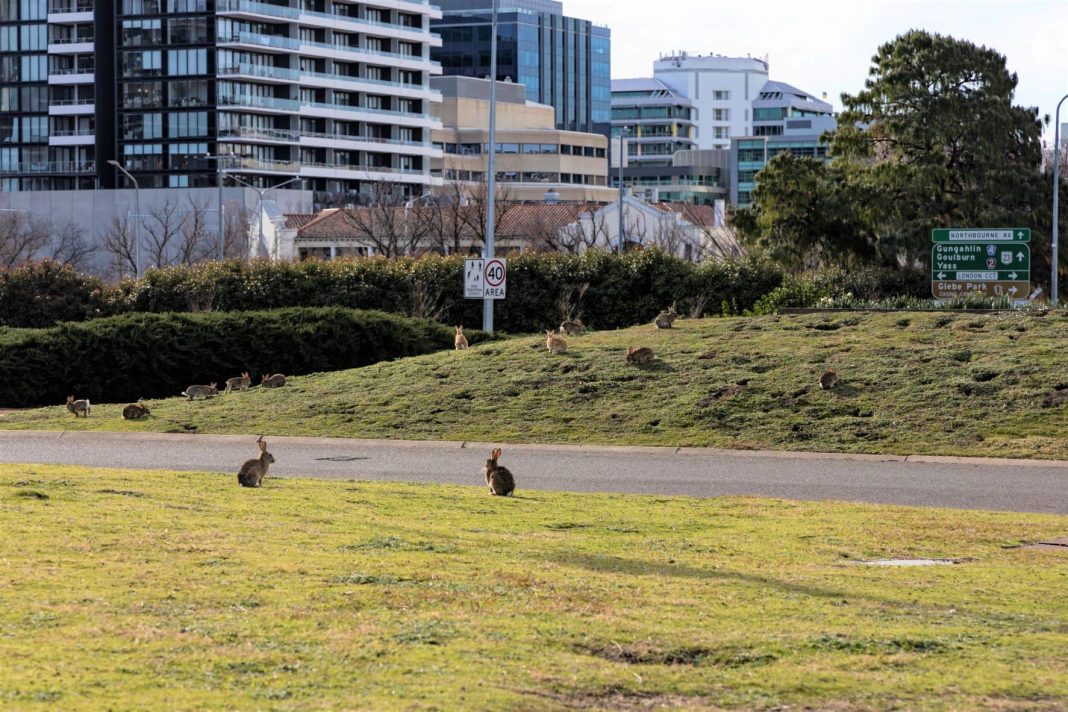They may be cute, but Canberra’s widespread rabbit population is threatening native species and conservation efforts, and they’re popping up literally everywhere.
Rabbits are a common sight in many urban areas, like the City Hill roundabout, but they’ve recently hopped into precious conservation territory, including the Jerrabomberra Wetlands.
In 2017, the ACT Government implemented a Rabbit Control Program which aimed to reduce numbers by releasing a strain of calicivirus into two populations of pest rabbits.
The virus-infected populations were living in an area of Namadgi National Park and land adjacent to Mulligans Flat Nature Reserve. Although the program was initially successful, populations have continued increasing.
ACT community organisation, Friends of Grasslands, have been tirelessly fighting to conserve Canberra’s natural environment since 1994, and the volunteer-led group are “very concerned” over the increase in rabbit numbers.
President of Friends of Grasslands, Jamie Pittock, says rabbits are a major threat to the flora and fauna in our bushland.
“The first key concern is they eat particular plants to extinction, so we need to control the number of rabbits so key wildflower species can survive. The second concern is they support the high population of predator cats and foxes which then also prey on native wildlife,” says Mr Pittock.
“We appreciate the ACT Government does undertake rabbit control, and we understand it’s difficult to scale up the control during the wet season. But we’re concerned with the limited number of contractors undertaking these control efforts.”
Mr Pittock says he would like to see the ACT Government put more effort in training and accrediting more contractors who can assist in rabbit population control efforts.
“Every control measure has its pluses and minuses. With the virus program, the danger is that it’s initially successful, but the surviving rabbits then develop a degree of immunity making it less successful, especially in the good seasons,” he says.
He explains that complementary efforts are necessary to control the rabbit population and relying solely on the virus isn’t enough.
But Mr Pittock, the self-titled ‘King of the Grass’, isn’t the only conservationist in Canberra concerned by the growing rabbit numbers.
Project Coordinator at the Molonglo Conservation Group, Jed Pearson, has always loved the bushlands surrounding Canberra and says it’s a “one-of-a-kind landscape”.
After studying conservation land management, Mr Pearson spends his days looking after the grasslands in the ACT and says rabbits are “definitely a problem” in Canberra.
“They definitely cause erosion issues by burrowing and they tend to be pretty hard on native plants. They eat the whole plant, not just the root or leaf, so it dies and then leaves the ground exposed,” he says.
“I’m not sure what they [the ACT Government] are doing around Canberra to bring them into check. I’ve seen a lot of them lately around Weston Creek and the wetlands, and there’s a lot around the Jerrabomberra Wetlands and Narrabundah Wetlands.”
He says during the push to try and control the feral cat numbers, the focus was shifted off the rabbit population. Now that the cat numbers are contained, he hopes the ACT Government will put more effort into reducing the rabbit population.
The Manager for Invasive Species and Overabundant Wildlife at the Environment, Planning and Sustainable Development Directorate (EPSDD) for the ACT Government, Mark Sweaney, said rabbits are the most significant environmental pest in the ACT.
“Controlling the rabbits is one of our top priorities. It’s always more challenging in seasons like this with the combination of really good food available to them, together with a probable decline in the effectiveness of bio controls,” says Mr Sweaney.
“We monitor the rabbits across all of our conservation and parklands through spotlight monitoring, and wherever rabbits exceed an environmental threshold, they’re treated with well-established techniques.”
Mr Sweaney says although the rabbit population is one of the EPSDD’s main priorities, many of the groups don’t reach the threshold level to implement higher control methods.
“If the rabbit population gets above a certain density, then they can have an impact on the environment. We have a threshold so we can control rabbits before they have those impacts but few reserves at the moment have too many rabbits,” he says.
“Although control programs are still happening right now, as autumn is a good time to treat rabbits, we’re still in a situation where the majority of reserves are below the threshold. Nowhere is so high that we’re concerned about serious damage before we can control them.”
He explains the EPSDD focus their efforts on controlling rabbits in certain areas across Canberra where they’ll have the best advantage in reducing the population.
“If there’s a lot of rabbits but they’re not causing a huge amount of damage, we don’t put resources there.”
According to Mr Sweaney, the control methods currently being used are continuing to have “really good” success in reducing the feral rabbit population.
Canberra Daily would love to hear from you about a story idea in the Canberra and surrounding region. Click here to submit a news tip.



